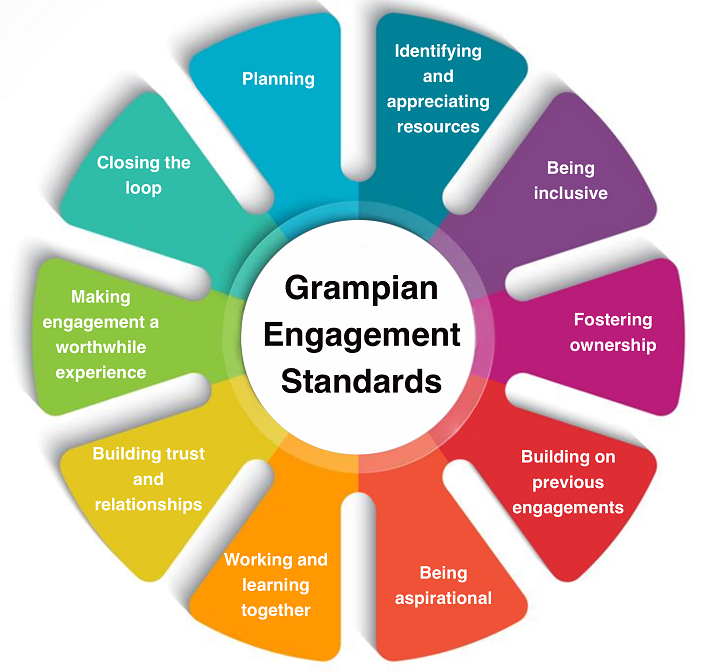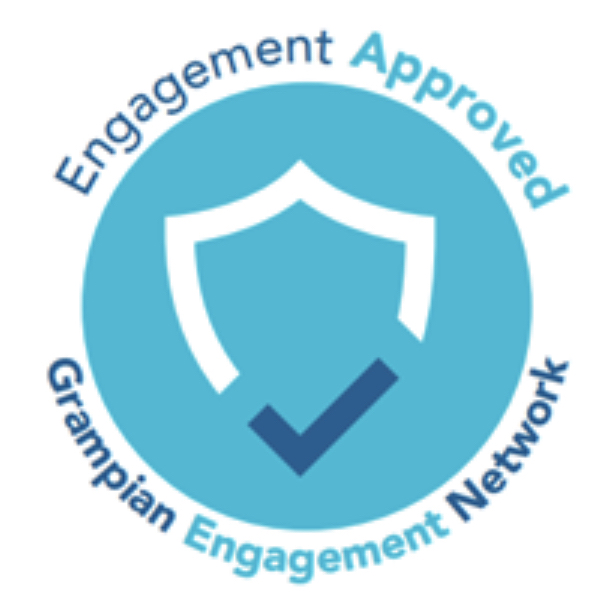Hallmark for Engagement – 10 considerations
The Hallmark for Engagement was co-created by the Grampian Engagement Network (GEN). as part of a specific piece of work the GEN undertook a programme of training and investigation to explore the key approaches to engagement, namely
- Scottish Approach to Service Design (SAtSD)
- National Standards for Community Engagement
- Planning with People
The following 10 considerations are the culmination of this work, based upon analysis and theming of the discussions that took place.
The below is intended to be used as a benchmark for good quality engagement and covers both values and approaches.
For a practical guide to good quality engagement please use the National Standards for Community Engagement which can be found by clicking here.
1) Planning
Good planning is vital, particularly having clarity on the purpose for your engagement and what level of engagement you are undertaking (informing, consulting, co-producing). To plan effectively you can use a tool like VOiCE which can be found by clicking here.
2) Identifying and appreciating resources
Before you begin to engage, it’s important to identify that you have sufficient resources, this could include staff and community capacity, money, time, people, space, etc. Your aspirations for engagement should be proportionate to the resources you have available. It’s important not just to identify resources but to also appreciate them – this will help to build trust and relationships.
3) Being inclusive
Inclusion and equality should be at the heart of any good engagement. Think about how any barriers to engagement can be overcome so that access is as equal as possible.
4) Fostering ownership
Engagement is at its best when as many people as possible commit to and own it. This is at all levels within and across organisations and partnerships. Understanding is a key part of ownership so it’s important to build knowledge about engagement, including at senior levels where decisions are more likely to be made.
5) Building on previous engagements
It’s essential to review the findings from previous relevant engagements – what you need to know may already have been fully, or partially, established by previous work. This has three key benefits – it shows you are valuing things the community have already told you; it can avoid over-consultation; it can help to develop ongoing engagement and relationships.
6) Being aspirational
This may be about pushing boundaries, embracing new ways of engaging such as online or engaging with people you haven’t previously. Trying new things generally improves the quality of your engagement work over a period of time.
7) Working and learning together
Collaboration is essential to ensure that individual engagements take account of and add value to each other. This co-production approach will help to avoid unnecessary repetition and consultation fatigue. Also vital here is valuing lived experience equally to professional experience.
8) Building trust and relationships
This is the best way to achieve meaningful, ongoing dialogue. Being open and honest is key e.g., your motivations for engagement; what can be influenced by the engagement, and importantly, what can’t. What other factors, alongside the learning from engagement, will influence final decisions; what resources are available.
9) Making engagement a worthwhile experience for participants
This isn’t about how engagement has influenced decisions. It’s trying to ensure that the act of engagement has been positive e.g., felt enjoyable, building on and sharing skills; meeting new people; being interested; having fun; being empowered.
10) Closing the loop
This emphasises the importance of feeding back to participants, and the community more generally, what the outcomes and influence of the engagement have been, even if it is none. It also covers the importance of learning from the engagement activity – what worked well and what needs improved. This will allow you to build a base of evidence for what good quality engagement looks like for you, and will hopefully also ensure a welcome next time you need to ask for people’s views.


